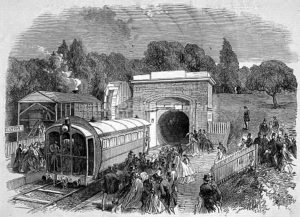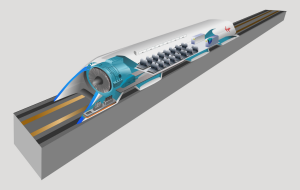Hyperloop: plus ca change…
The laws of physics are constant. Once you understand them, your solutions to challenges like transportation are always going to look pretty similar. Which is why the Hyperloop is not new. It combines the technology of pneumatic trains, first deployed in the UK in the 1860s, with the technology of magnetic levitation, first demonstrated as a technology for trains in 1913.
This is not to say that the engineering challenge of the Hyperloop is simple. It will be a great feat when completed, and take advantage of huge leaps in our application of science since the days of the pneumatic train: computing, new materials, batteries, solar power and much, much more.
But the challenges it faces may not have changed much at all.

G-Force
The hyperloop is, by its nature, an intercity transport platform. To get the advantages of its high speed, you need to be travelling a reasonable distance. Otherwise it has no chance to get up to speed before it is stopping again. Rough maths time: the proposed top speed of the hyperloop is around 1200 kilometres per hour, which is about 333 metres per second. At maximum acceleration, a Tesla car can pull about 1g or 10 m/s2 acceleration. That would get you near enough top speed in 30 seconds.
By comparison, a Pendolino train can reportedly accelerate at a maximum of 0.43 m/s2 — i.e. it takes 60 seconds to reach 60mph. Let’s say that the hyperloop can comfortably accelerate somewhere between the two. At slightly more than Pendolino rate, it’s going to take 11 minutes and perhaps more importantly, 54km, to get up to top speed. Crank the acceleration up to 2m/s2 and that comes down to 2m45s and 13.6km. At 5m/s2 it falls to just over a minute and 5km.
Now this may seem extreme, accelerating ten times as fast as a Pendolino, and I know some people who would be put off by that. Half a g is more than you would experience on takeoff and landing on a commercial airliner, for example — perhaps 2–3 times as much — though you might experience more on banking.
This, though, is what is proposed.
Stop and go
With 5km to get up to speed, and 5km to stop, on a short hop like Manchester to Liverpool (roughly 30 miles/50km), you’re only going to be at cruising speed for a couple of minutes. Indeed, the Northern Arc proposal suggests six minutes from Liverpool to Manchester, and seven from Manchester to Leeds. This would be absolutely transformative, genuinely making these cities part of the same economic zone, if the cost of travel is reasonable. Even Glasgow could be under an hour from Liverpool.
But this presents the new issue: how do you find the space for new tunnels — underground or in the air — between and through these densely-populated, organically-grown and mostly privately-owned urban areas? And how do you pay for those works?
If you look at the cost breakdown for HS2, it’s interesting to see that over £1.8bn of the original budget (since dramatically expanded) is allocated to land costs — half of that has already been spent. Once you strip out risk (nearly £13bn of the £33bn original 2011 costings), the biggest line items are tunnels, bridges, viaducts, and the construction works around the tracks themselves. These will be different for hyperloop but it’s hard to see how they will be *that* different.
Future technology in today’s world
I would *love* to see the Hyperloop become a reality in the UK, particularly the Northern Arc project that would have such benefits for the north of England and Scotland. But I fear that its futuristic vision may be stymied, or at the very least, slowed, by the challenges of construction in a complex and expensive environment.
For once as a futurist, I hope I’m wrong.
